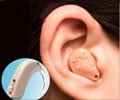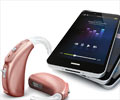A new flexible hearing aid uses micro-epidermal actuators to non-invasively improve hearing, offering a solution for conductive hearing loss, especially in children.
- A new flexible hearing aid offers a non-invasive solution to conductive hearing loss, bypassing the need for surgery or implants
- Micro-epidermal actuators deliver vibrations directly to the inner ear, improving sound quality
- It has the potential to reduce developmental delays in children, and transform pediatric hearing aids
Array of micro-epidermal actuators for noninvasive pediatric flexible conductive hearing aids
Go to source). Conductive hearing loss, most commonly occurring in childhood, happens when sound waves are blocked from reaching the inner ear due to issues in the outer or middle ear, such as infections, blockages, or structural abnormalities. The research was led by Mohammad J. Moghimi, Ph.D., assistant professor of biomedical engineering, at Wake Forest University School of Medicine.
The skin in ear canal grows at a rate of around 1.3 inches per year, you get a “new” ear canal every 12 months when the old skin sheds. #medindia #ear #skin’
Using Micro-Epidermal Actuators for Sound Transmission
To generate vibrations strong enough to reach the cochlea, the part of the inner ear responsible for hearing, the research team created a flexible hearing aid. This device uses micro-epidermal actuators to produce vibrations on the skin behind the ear, allowing the sound to bypass the ear canal and directly reach the inner ear.In the study, 10 participants aged 19 to 39 wore earplugs and earmuffs to simulate conductive hearing loss. The researchers then tested different actuator arrays to increase the vibration strength, improve sound quality, and control the direction of the vibrations.
Array of Actuators for Better Hearing Performance
“We found that using an array of these actuators, rather than a single one, significantly enhances the strength and quality of the vibrations, leading to better hearing outcomes,” Moghimi said.Moghimi also emphasized that enhancing hearing in children can help prevent delays in language and speech development, as well as support their educational progress.
The research team plans to conduct a larger study next to further assess the device's efficacy and safety in both children and adults.
- Array of micro-epidermal actuators for noninvasive pediatric flexible conductive hearing aids - (https://www.nature.com/articles/s44172-025-00369-7)
Source-Medindia
















